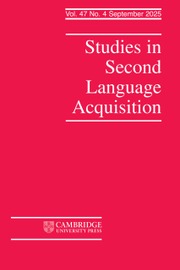Article contents
ASYMMETRIES IN UNIVERSAL GRAMMAR The Role of Method and Statistics
Published online by Cambridge University Press: 01 June 2000
Abstract
Felix (1988) claimed to demonstrate that UG-based knowledge of grammaticality causesnonnative speakers (NNSs) to have more accurate grammaticality judgments on sentences thatare ungrammatical according to UG than on those that are grammatical. Birdsong (1994)criticized the methodology employed, noting that it ignores “response bias” (apropensity to judge sentences as ungrammatical) as a potential explanation. Felix and Zobl(1994) dismissed this criticism as merely methodological. In this paper, Birdsong'scriticism is upheld by considering a statistical model of the data. At the same time, a morecomplete logistic regression model allows a fuller statistical analysis, revealing tentative supportfor the asymmetry claim, as well as differential learning states for different constructions and atendency toward transfer avoidance. These theoretically significant effects were unnoticed in theearlier discussion of this research. For SLA research on grammaticality judgments to proceedfruitfully, appropriate statistical models need to be considered in designing the research.
Information
- Type
- Research Article
- Information
- Copyright
- 2000 Cambridge University Press
- 3
- Cited by

